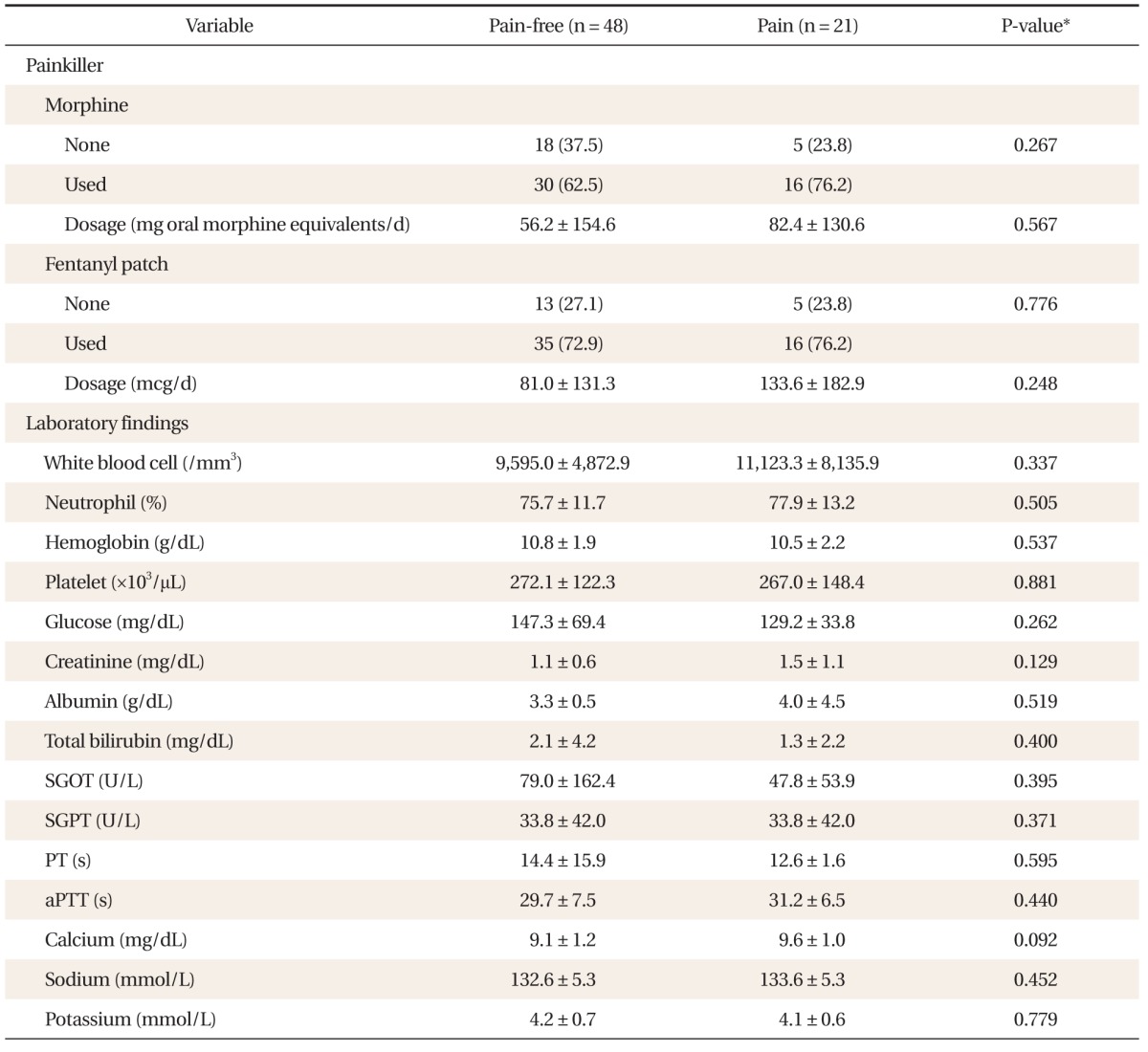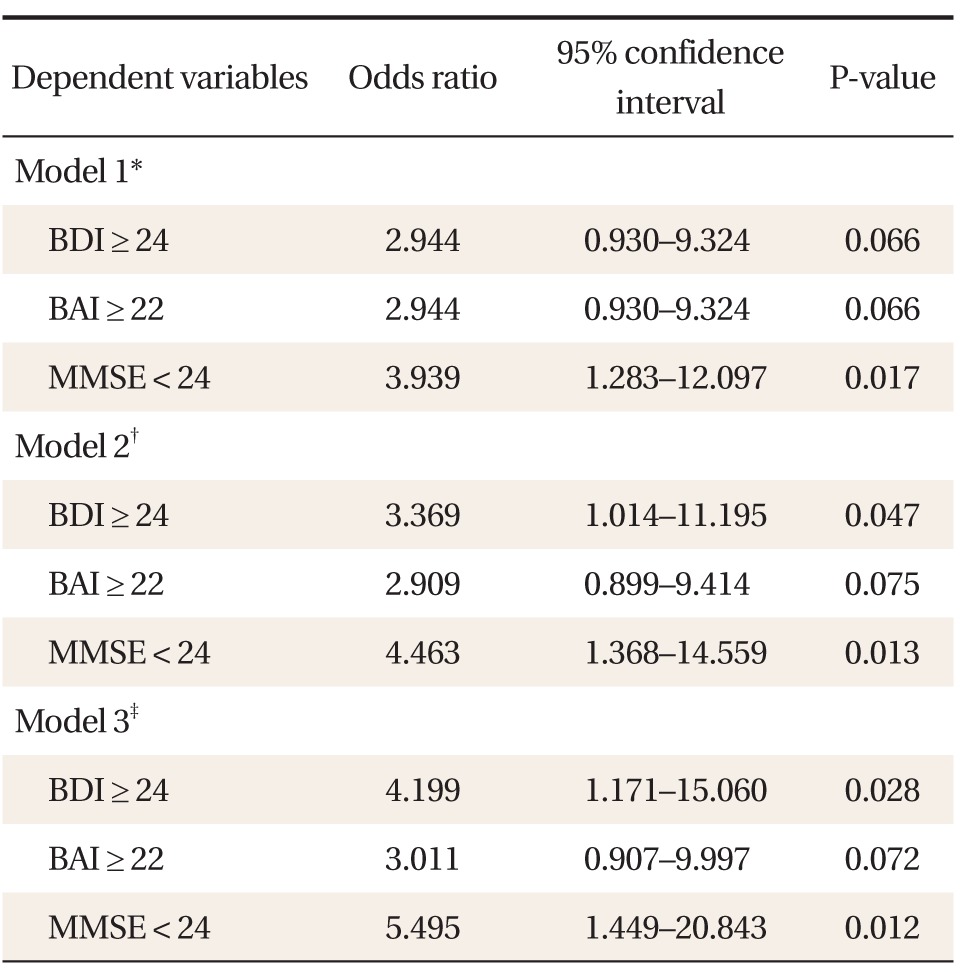2. Youn YH. Comprehension of advanced cancer patients and approach family medicine. J Korean Acad Fam Med 1998;19:979-986.
4. Choi JH, Byeon JJ, Lee S, Han SH. Preferred place of death of elderly women in Seoul. J Korean Acad Fam Med 2001;22:939-945.
5. Portenoy RK, Lesage P. Management of cancer pain. Lancet 1999;353:1695-1700. PMID:
10335806.


6. Daut RL, Cleeland CS. The prevalence and severity of pain in cancer. Cancer 1982;50:1913-1918. PMID:
7116316.


7. Foley KM. The treatment of cancer pain. N Engl J Med 1985;313:84-95. PMID:
2582259.


8. Kwon YC, Yun YH, Lee KH, Son KY, Park SM, Chang YJ, et al. Symptoms in the lives of terminal cancer patients: which is the most important? Oncology 2006;71:69-76. PMID:
17344672.


9. Davies RK, Quinlan DM, McKegney FP, Kimball CP. Organic factors and psychological adjustment in advanced cancer patients. Psychosom Med 1973;35:464-471. PMID:
4764539.


10. Song H, Li J, Lu Y, Deng L, Sun XL. Investigation of mental health and its influence on Chinese cancer patients using a multidisciplinary screening flow: an epidemiological survey in the west of China. Chin Med J (Engl) 2013;126:61-67. PMID:
23286479.


11. Arrieta O, Angulo LP, Nunez-Valencia C, Dorantes-Gallareta Y, Macedo EO, Martinez-Lopez D, et al. Association of depression and anxiety on quality of life, treatment adherence, and prognosis in patients with advanced non-small cell lung cancer. Ann Surg Oncol 2013;20:1941-1948. PMID:
23263699.


13. Castro M, Kraychete D, Daltro C, Lopes J, Menezes R, Oliveira I. Comorbid anxiety and depression disorders in patients with chronic pain. Arq Neuropsiquiatr 2009;67:982-985. PMID:
20069205.


14. Teunissen SC, de Graeff A, Voest EE, de Haes JC. Are anxiety and depressed mood related to physical symptom burden?: a study in hospitalized advanced cancer patients. Palliat Med 2007;21:341-346. PMID:
17656411.


15. Chen ML, Chang HK. Physical symptom profiles of depressed and nondepressed patients with cancer. Palliat Med 2004;18:712-718. PMID:
15623168.


16. Glover J, Dibble SL, Dodd MJ, Miaskowski C. Mood states of oncology outpatients: does pain make a difference? J Pain Symptom Manage 1995;10:120-128. PMID:
7730684.


17. Yang MJ, Jeon YW, Han SI, Han CW, Eom HS. Depression and pain in patients with cancer: a preliminary study. J Korean Neuropsychiatr Assoc 2000;39:1122-1131.
18. Yu SJ, Kim HS. The study of pain and depression in elderly cancer patients. J Korean Gerontol Nurs 2000;2:154-166.
19. Park HJ, Kim HN, Kim IB, Jeon SA. Reliability of the Beck depression inventory in adolescence. J Korean Acad Fam Med 2000;21:244-253.
20. Beck AT, Epstein N, Brown G, Steer RA. An inventory for measuring clinical anxiety: psychometric properties. J Consult Clin Psychol 1988;56:893-897. PMID:
3204199.


21. Ware JE Jr, Sherbourne CD. The MOS 36-item short-form health survey (SF-36). I. Conceptual framework and item selection. Med Care 1992;30:473-483. PMID:
1593914.


22. Koh SB, Chang SJ, Kang MG, Cha BS, Park JK. Reliability and validity on measurement instrument for health status assessment in occupational workers. Korean J Prev Med 1997;30:251-266.
23. McHorney CA, Ware JE Jr, Raczek AE. The MOS 36-item short-form health survey (SF-36): II. psychometric and clinical tests of validity in measuring physical and mental health constructs. Med Care 1993;31:247-263. PMID:
8450681.


24. Park JH, Kwon YC. Standardization of Korean of the minimental state examination (MMSE-K) for use in the elderly: Part II. diagnostic validity. J Korean Neuropsychiatr Assoc 1989;28:508-513.
25. Kwon YC, Park JH. Korean version of mini-mental state examination (MMSE-K). J Korean Neuropsychiatr Assoc 1989;28:125-135.
26. Noorani NH, Montagnini M. Recognizing depression in palliative care patients. J Palliat Med 2007;10:458-464. PMID:
17472517.


27. Ellis J, Lin J, Walsh A, Lo C, Shepherd FA, Moore M, et al. Predictors of referral for specialized psychosocial oncology care in patients with metastatic cancer: the contributions of age, distress, and marital status. J Clin Oncol 2009;27:699-705. PMID:
19114706.


28. Rao S, Ferris FD, Irwin SA. Ease of screening for depression and delirium in patients enrolled in inpatient hospice care. J Palliat Med 2011;14:275-279. PMID:
21247299.



29. Wilkinson SM, Love SB, Westcombe AM, Gambles MA, Burgess CC, Cargill A, et al. Effectiveness of aromatherapy massage in the management of anxiety and depression in patients with cancer: a multicenter randomized controlled trial. J Clin Oncol 2007;25:532-539. PMID:
17290062.


30. Price DD, Verne GN, Schwartz JM. Plasticity in brain processing and modulation of pain. Prog Brain Res 2006;157:333-352. PMID:
17167920.


31. Turk DC, Sist TC, Okifuji A, Miner MF, Florio G, Harrison P, et al. Adaptation to metastatic cancer pain, regional/local cancer pain and non-cancer pain: role of psychological and behavioral factors. Pain 1998;74:247-256. PMID:
9520239.


32. Moriarty O, McGuire BE, Finn DP. The effect of pain on cognitive function: a review of clinical and preclinical research. Prog Neurobiol 2011;93:385-404. PMID:
21216272.


33. Oosterman JM, Derksen LC, van Wijck AJ, Veldhuijzen DS, Kessels RP. Memory functions in chronic pain: examining contributions of attention and age to test performance. Clin J Pain 2011;27:70-75. PMID:
20842018.


34. Povedano M, Gascon J, Galvez R, Ruiz M, Rejas J. Cognitive function impairment in patients with neuropathic pain under standard conditions of care. J Pain Symptom Manage 2007;33:78-89. PMID:
17196909.



35. Weiner DK, Rudy TE, Morrow L, Slaboda J, Lieber S. The relationship between pain, neuropsychological performance, and physical function in community-dwelling older adults with chronic low back pain. Pain Med 2006;7:60-70. PMID:
16533199.


36. Meyer JS, Thornby J, Crawford K, Rauch GM. Reversible cognitive decline accompanies migraine and cluster headaches. Headache 2000;40:638-646. PMID:
10971660.


37. Hede K. Chemobrain is real but may need new name. J Natl Cancer Inst 2008;100:162-163. 169PMID:
18230787.


38. Ahles TA, Saykin AJ. Candidate mechanisms for chemotherapy-induced cognitive changes. Nat Rev Cancer 2007;7:192-201. PMID:
17318212.



39. Mystakidou K, Parpa E, Tsilika E, Pathiaki M, Gennatas K, Smyrniotis V, et al. The relationship of subjective sleep quality, pain, and quality of life in advanced cancer patients. Sleep 2007;30:737-742. PMID:
17580595.



40. Schultheis K, Hofheinz RD, Gencer D, Blunk JA, Benrath J. Quality of life and symptom evaluation in daily oncology practice: a survey of 150 patients with advanced gastrointestinal tumours receiving palliative chemotherapy. Onkologie 2013;36:33-37. PMID:
23429329.














